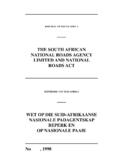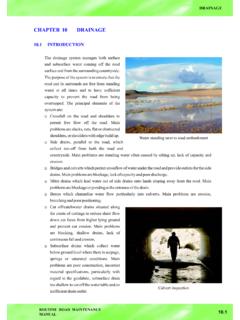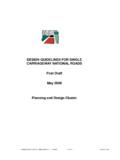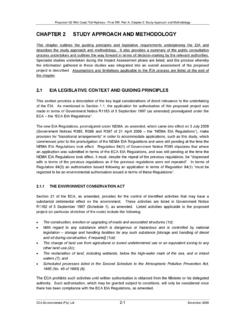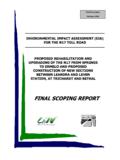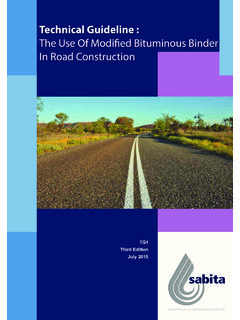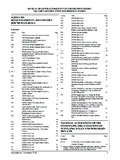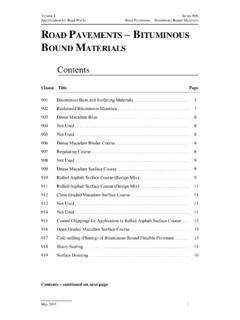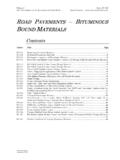Transcription of CHAPTER 7. ROAD PAVEMENT REPAIRS - GENERAL
1 CHAPTER PAVEMENT REPAIRS - MaterialEmulsion Treated BaseIn this section the materials and equipment most commonly used in PAVEMENT repair work are outlined. Then follow descriptions of the various types of PAVEMENT and surfacing failures and problem areas together with the actions required to address , lime and emulsions are available from suppliers in sacks or drums. Cement and lime sacks should not be left outdoors and should be used within the first three months of supply. Certain emulsions such as latex modified material can separate out with time and become unusable. Crushed stone and crusher sand should be obtained from reputable commercial sources and should be checked for grading, hardness and dust content. Where local PAVEMENT materials are intended for re-use or to be left in place these should be tested and laboratory testing should take particular regard of bearing strength and there are numerous repair materials (normally specified in detail in the contract documents) the following are commonly used on routine indicates that the use of unsuitable material is the primary cause of early failure of base REPAIRS .
2 Because it can be difficult to be certain of the quality of in situ base material it is suggested that on heavily trafficked routes this material should be an imported non or low plasticity crushed stone which should be stockpiled only when the material will be used over an extended period. Other base material should be used only where there is good confidence that it will perform satisfactorily. The use of cementing agents such as lime and cement is not recommended as they can give rise to cracking and cause the treated material to act as a rigid block in a flexible layer giving rise to unequal performance under traffic. However, as an emergency temporary repair, a good quality gravel with a small percentage of cement can be treated base (ETB) is the preferred material to be used in granular PAVEMENT REPAIRS .
3 The ETB should consist of a crushed stone base optimum fluid content (emulsion plus water) to enable maximum treated with 3% anionic stablemix emulsion and 1% cement (by mass). The treated material should be mixed with water to achieve an road PAVEMENT REPAIRS - slurry on siteROUTINE road MAINTENANCEMANUALA sphalt BaseEmulsionsHandsprayed SealsModified Cape SealPreformed RoadpatchGeofabric BandageSlurrybound MacadamAsphalt SurfacingCold MixHot asphalt base should be obtained from commercial sources to a mix design approved by SANRAL. Use depends on the proximity of an asphalt plant. Cold mix asphalt should only be used as a temporary emergency repair to maintain road of ease of handling and low application temperatures, emulsion is favoured for maintenance work, particularly where small quantities are required.
4 The use of Latex (3% to 5%) is recommended due to its improvement of the emulsion properties. Where the emulsion is stored in drums any separation can be dealt with by rolling the drum (say 20m) before use. Where bulk storage is used the static tank should be fitted with a pump and the emulsion should be circulated regularly (say once a week).These typically consist of a 13mm surfacing chip with split application of emulsion and a grit choke layer or a 19mm and 6,7mm double seal with a final fog consists of a tack coat of emulsion (preferably modified) with a chip size dependent on the layer thickness required (19mm recommended) and a slurry. A light penetration cover spray might be necessary to hold the chip during road patches should be obtained from commercial sources and consist of a range of chip sizes on bitumen rubber on a backing geofabric bandage consists of a rectangular piece of geofabric tacked to the road surface using a latex modified emulsion.
5 The bandage should be "armoured" by covering with a further application of latex modified emulsion and a nominal 4,75mm grit. All binder applications and materials used should be as per the supplier's single size stone aggregate vibrated in place and infilled with a fine asphalt would normally be obtained from commercial sources to an approved design. Use depends on the proximity of an asphalt plant and the quantity site mixing of small amounts of "hot" asphalt can be achieved using a concrete mixer and gas burners (refer to Figure 1). Using this method, quantities adequate for local patches, edgebreak and pothole REPAIRS can be produced at a temperature of about 120 C. With care, good mixing and adequate rolling, a dense asphalt can be asphalts either premixed (with cut backs) or made on site with emulsion have throughout the country a poor performance record.
6 Either the cold asphalt shoves during hot weather (high binder content) or is PAVEMENT REPAIRS - GENERALROUTINE road MAINTENANCEMANUAL porous and allows the ingress of water which causes base failure or the asphalt ravels in wet weather (low binder content).Certain proprietary products however, could be considered for use in temporary pothole or road failure REPAIRS . Such products can be transported in the route patrol vehicles and potholes can be temporarily repaired immediately they are current industry approach is that these types of products should be Agr ment SA approved. SANRAL should be consulted on the use of proprietory products for temporary REPAIRS . It is important that all cold mix asphalts are tested for permeability after compaction. Where permeability is a problem, the patch should be sealed using an appropriate product or the asphalt replaced with an impermeable of mixing and batching for on site mixed materials are given in in SABITA's Bituminous PAVEMENT REPAIRS for slurry bound macadam.
7 This document is included in Appendix D. While materials can be mixed by hand on a hardened piece of ground or in a wheelbarrow, far better control and uniformity can be achieved using a small concrete mixer which also reduces wastage and 9,5mm and 6,7mm surfacing stone and a crusher sand (suitable for slurry) make up samples to achieve a smooth continuous grading. Have the grading checked in the laboratory. Make up trial mixes with 5% to 6% net bitumen content using a 60% stablemix emulsion heating the mixture to 125 C and carry out Marshall tests. Obtain advice on the optimum mix proportions. Be very careful in working out volume proportions on site. The best way to do this is to fill containers (known volume) and weigh the contents to establish volume-mass relationships. Where the asphalt material is being used in low traffic areas such as edgebreak REPAIRS the quantity of emulsion added can be increased by 10%.
8 As a very rough check the amount of 60% emulsion per cubic metre of loose aggregate should be between about 125 and out the quantity of asphalt required and then decide on the size of batch or number of batches needed. MIXES AND MIXINGOn Site "Hot" AsphaltTypical 1 - Heating of asphalt mixtureROAD PAVEMENT REPAIRS - GENERALROUTINE road MAINTENANCEMANUALU sing clearly marked standard calibrated containers charge the concrete mixer as follows:i)Add and heat the stone fraction of the aggregate to at least 110 Cii)Add the stablemix emulsioniii)Add the crusher sandMix all the constituents while still heating until all the particles are well a guide, directly after mixing the asphalt should be at a temperature of between 120 and 125 C and have a uniform appearance. Before placing the asphalt the road surface should be "tacked" with a dilute application of equipment normally needed on routine maintenance is conventional small plant used on civil engineering works.
9 However, special equipment or modifications to equipment have been found to work for cracksealing, binder application, weedkillers and "hot" back hand pump delivers a pressure of 2 bars and can be used for spraying bituminous emulsions (including polymer modifiers) with a special spray nozzle. The equipment is ideal for the handsprays mentioned in the section on Materials. By changing the nozzle to a single jet (3mm) the equipment can be used for cracksealing of single standard concrete mixer can be modified by setting up an industrial gas burner and bottle to feed hot air into the mouth of the mixer (see Figure 1). This set up can be used to produce small amounts of "hot" asphalt on site suitable for local patch REPAIRS .
10 For mix and mixing procedures refer to the paragraph on Materials, Asphalt Surfacing. The material can either be mixed in the yard and hauled to site by bakkie or the mixer, burners and aggregate can be set up on a flatbed truck. Measuring containers can be either buckets or boxes, but should be of standard sizes and have a Modifications for Small Hot Asphalt sprayerROAD PAVEMENT REPAIRS - GENERALROUTINE road MAINTENANCEMANUALE quipment for Heating Small Quantities of binder or SealantScreedbars/RailsCrack OF road FAILURESB inders and sealants are highly flammable and must not be heated with a direct flame. It is strongly recommended that binders be heated using a double boiler principle as follows:Cut a 210l drum in half and attach three steel legs to form a boiler.
